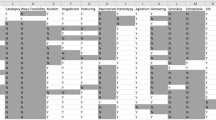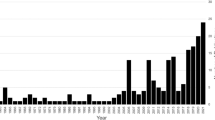Abstract
Catatonia, once solely attributed to schizophrenia, is now thought to be associated with many disorders. Autistic disorder shares some symptoms with catatonia, namely, mutism, echopraxia/echolalia, and stereotypies. Catatonia in autism may therefore be a variant of the autistic condition. However, organic deficits and psychiatric disorders, such as bipolar disorder, have also been linked with the manifestation of catatonia. Individuals with autism presenting with these comorbid conditions may therefore be at increased risk for catatonia. Little is written of the association of autism and catatonia to clarify the possibility of catatonia as a variant or a sign of a comorbid condition. The authors discuss three autistic patients and suggest specific etiologies for the symptoms of catatonia which presented in these cases. The therapeutic and diagnostic importance of comorbid disorders in autism is stressed.
Similar content being viewed by others
References
Abrams, R., & Taylor, M. A. (1977). Catatonia: prediction of response to somatic treatments.American Journal of Psychiatry, 134, 78–80.
Abrams, R., Taylor, M. A., & Stolurow, K. A. C. (1979). Catatonia and mania: Patterns of cerebral dysfunction.Biological Psychiatry, 14, 111–117.
Akthar, S., & Buckman, J. (1977). The differential diagnosis of mutism: A review and report of three unusual cases.Diseases of the Nervous System, 38, 558–563.
Altshuler, L., Cummings, J. L., & Mills, M. J. (1986). Mutism: Review, differential diagnosis, and report of 22 cases.American Journal of Psychiatry, 143, 1409–1414.
American Psychiatric Association. (1968).Diagnostic and statistical manual of mental disorders (2nd ed.). Washington, DC: Author.
American Psychiatric Association. (1980).Diagnostic and statistical manual of mental disorders (3rd ed.). Washington, DC: Author.
American Psychiatric Association. (1987).Diagnostic and statistical manual of mental disorders (3rd ed., rev.). Washington, DC: Author.
Bemporad, J. (1979). Adult recollections of a formally autistic child.Journal of Autism and Developmental Disorders, 9, 179–197.
Bender, L. (1947). Childhood schizophrenia: A clinical study of 100 schizophrenic children.American Journal of Orthopsychiatry, 17, 40–56.
Bleuler, E. (1908).Dementia praecox, or the group of schizophrenias (J. Zinkin, Trans.). New York: International Universities Press.
Campbell, M., Fish, B., Korein, J., Shapiro, T., & Collins, P. (1972). Lithium and chlorpromazine: A controlled crossover study of hyperactive severely disturbed young children.Journal of Autism and Childhood Schizophrenia, 2, 234–263.
Coleman, M., & Gillberg, C. (1985).The Biology of the autistic syndromes (p. 25). New York: Praeger.
Delong, R. G., & Dwyer, J. T. (1988). Correlation of family history with specific autistic subgroups: Asperger's syndrome and bipolar affective disease.Journal of Autism and Developmental Disorders, 18, 593–600.
Despert, J. C. (1938). Schizophrenia in children.Psychiatric Quarterly, 12, 366–371.
Galenberg, A. J. (1976). The catatonic syndrome.Lancet, 1, 1339–1341.
Goldfarb, W. (1974).Growth and change-Schizophrenic children. New York: Wiley.
Hall, D. C., & Ries, R. K. (1983). Bipolar illness, catatonia and the dexamethasone suppression test in adolescence: Case report. Journal of Clinical Psychiatry, 44, 222–224.
Hockaday, T. D. R., Keynes, W. M., & McKenzie, J. K. (1966). Catatonic stupor in an elderly female with hyperparathyroidism.British Medical Journal, 1, 85–87.
Johnson, G. C., & Manning, D. E. (1983). Neuroleptic-induccd catatonia: Case report.Journal of Clinical Psychiatry, 44, 310–312.
Johnstone, E. C., Crow, T. J., Frith, D. C., Husband, J., & Kreel, L. (1976). Cerebral ventricular size and cognitive impairment in schizophrenia.Lancet, 2, 924–926.
Joseph, A. B., Anderson, W. H., & O'Leary, D. H. (1985). Brainstem and vermis atrophy in catatonia.American Journal of Psychiatry, 142, 352–254.
Kahlbaum, K. L. (1974).Catatonia 1873. Baltimore, MD: Johns Hopkins University Press.
Kanner, L. (1943). Autistic disturbances of affective content.Nervous Child, 2, 217–250.
Kolvin, I. (1971). Studies in the childhood psychoses: Diagnostic criteria and classification.British Journal of Psychiatry, 118, 381–384.
Komoto, J., Usui, S., & Hirata, J. (1984). Infantile autism and affective disorder.Journal of Autism and Developmental Disorders, 14, 81–84.
Kraepelin, E. (1905). In T. Johnstone (Ed.),Lectures on clinical psychiatry (2nd ed.). New York: William Wood.
Morrison, J. R. (1974). Catatonia: Prediction of outcome.Comprehensive Psychiatry, 15, 317–324.
Nielson, J. M. (1953). Wernicke's encephalopathy: Correlation of sites of lesion with symptomatology.Journal of Nervous and Mental Disease, 118, 429–434.
Pearlson, G. D., Kim, W. S., Kubos, K. L., Moberg, P. J., Jayaram, G., Baxcom, M. J., Chase, G. A., Goldfinger, A. D., & Tune, L. E. (1989). Ventricle brain ratio, computed tomographic density, and brain area in 50 schizophrenics.Archives of General Psychiatry, 46, 690–697.
Penn, H., Rocy, J., & Lapham, L. (1970). Catatonic behavior, viral encephalopathy and death.Archives of General Psychiatry, 27, 758–761.
Petty, T., Ornitz, E., Michelman, J. D., & Koh, C. (1984). Autistic children who become schizophrenic.Archives of General Psychiatry, 41, 129–135.
Raskin, D. E., & Frank, S. W. (1974). Herpes encephalitis with catatonic stupor.Archives of General Psychiatry, 31, 544–546.
Reimer, D. R., & Nagaswami, S. (1974). Catatonic schizophrenia associated with cerebral arterial malformations and with membranous glomerulonephritis.Psychosomatics, 15, 39–40.
Ries, R. K. (1985). DSM-III implications of the diagnoses of catatonia and bipolar disorder.American Journal of Psychiatry, 142, 1471–1474.
Rutter, M. (1972). Child schizophrenia reconsidered.Journal of Autism and Developmental Disorders, 2, 315–337.
Shah, P., & Kaplan, S. (1980). Catatonic symptoms in a child with epilepsy.American Journal of Psychiatry, 137, 6.
Sternbach, H., & Yager, J. (1981). Catatonia in the presence of midbrain and brainstem abnormalities.Journal of Clinical Psychiatry, 42, 352–353.
Taylor, M. A., & Abrams, R. (1977). Catatonia: Prevalence and importance in the manic phase of manic depressive illness.Archives of General Psychiatry, 34, 1223–1225.
Tippin, J., & Dunner, F. (1981). Biparietal infarctions in a patient with catatonia.American Journal of Psychiatry, 138, 10.
Weinberger, D. R., Torrey, E. F., Neophytides, A. N., & Wyatt, R. J. (1979). Lateral ventricular enlargement in chronic schizophrenia.Archives of General Psychiatry, 36, 735–739.
Wing, L., & Attwood, A. (1987). Syndromes of autism and atypical development. In D. Cohen & A. Donnellan (Ed.),Handbook of autism and pervasive developmental disorders (pp. 3–19). New York: Wiley-Interscience.
Woods, S. W. (1980). Catatonia in a patient with subdural hematomas.American Journal of Psychiatry, 137, 983–984.
Author information
Authors and Affiliations
Additional information
This work was supported in part by the Wisniewski fellowship of the Office of Mental Retardation of the State of New York and the Alex Kunin Fund. The authors thank the parents of the affected individuals for their assistance in data gathering, the Twin Cities Society for Children and Adults with Autism for their support of research in autism in Minnesota, Pattianne Gumatz for project coordination, and especially Lois Laitinen for expert manuscript preparation.
Rights and permissions
About this article
Cite this article
Realmuto, G.M., August, G.J. Catatonia in autistic disorder: A sign of comorbidity or variable expression?. J Autism Dev Disord 21, 517–528 (1991). https://doi.org/10.1007/BF02206874
Issue Date:
DOI: https://doi.org/10.1007/BF02206874




